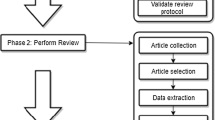Abstract
While determining information systems architectures (ISA), business systems planning (BSP) is a well-known method to join processes and data classes to subsystems. BSP matrices have generally been rearranged without describing the underlying methods. Meanwhile, various techniques have been developed for solving the ISA problem. Since exact optimization methods often fail to provide results for large ISA problems, different heuristics have been applied. A new heuristic for solving the ISA problem is the application of genetic algorithms (GA). This paper examines the application of a simple GA to the ISA problem and compares the results of applying the GA with those obtained by exact methods.
Zusammenfassung
Zur Entwicklung von Architekturen von Informationssystemen (ISA) wird vielfach das Business-Systems-Planning-(BSP)-Konzept vorgeschlagen. Ein Teilproblem dieses Planungskonzepts besteht darin, unter Berücksichtigung von Optimalitätskriterien Unternehmensprozesse und Datenbestände zu möglichst voneinander unabhängigen Teilsystemen zusammenzufassen. Da die Leistungsgrenzen von exakten Optimierungsverfahren für dieses Problem rasch erreicht werden, interessiert der Einsatz von heuristischen Verfahren. Zunächst werden das BSP-Problem und die Vorgehensweise genetischer Algorithmen kurz erläutert. Danach wird die Anwendung eines einfachen genetischen Algorithmus auf das BSP-Problem beschrieben. Ein Vergleich mit Ergebnissen exakter Verfahren bildet einen weiteren wichtigen Bestandteil der Untersuchung.
Similar content being viewed by others
References
Brathwaite KS (1992 Information Engineering, Vol. I. Concepts. CRC, Boca Raton
Brown DE, Huntley CL, Spillane AR (1989) A Parallel Genetic Heuristic for the Quadratic Assignment Problem. In: Schaffer JD (ed) Proceedings of the 3rd International Conference on Genetic Algorithms. Morgan Kaufmann, San Mateo, pp 406–415
Flaatten PO et al. (1989) Foundations of Business Systems. Dryden, Chicago
Goldberg DE (1989) Genetic Algorithms in Search, Optimization, and Machine Learning. Addison-Wesley, Reading, Mass.
Grefenstette J (1991) Documentation for GENESIS. The Software Partnership
Hein KP (1985) Information System Model and Architecture Generator. IBM Syst J 24:213–235
Hess J (1993) Implementierung von Branch-and-Bound Verfahren zur Strukturierung von BSP-Matrizen. Master Thesis, University of Bern
IBM (ed) (1978) Business Systems Planning: Information Systems Planning Guide. IBM-Form, GE 20-0527-2
IBM (ed) (1990) Information System Model and Architecture Generator, Operation Guide, Release 1.3. IBM-Form SE 11-5989-2
Katz RL (1990) Business/enterprise modeling. IBM Syst J 29:509–525
Kiewiet DJ, Stegwee RA (1991 Conceptual Modeling and Cluster Analysis: Design Strategies for Information Architectures. In: DeGross JI et al. (eds) Proceedings of the 12th International Conference on Information Systems. ACM, Baltimore, pp 315–326
Kim YG, Everest GC (1994) Building an IS architecture. Inf & Manag 26:1–11
Knolmayer G (1994) The Application of Mixed Integer Programming to the “Business Systems Planning”-Problem. In: Dyckhoff H et al. (eds) Operations Research Proceedings 1993. Springer, Berlin, pp 457–463
Knolmayer G, Spahni D (1993) Darstellung und Vergleich ausgewählter Methoden zur Bestimmung von IS-Architekturen. In: Reichel H (ed) Informatik, Wirtschaft, Gesellschaft. Springer, Berlin, pp 99–104
Krcmar H (1990) Bedeutung und Ziele von Informationssystem-Architekturen. Wirtschaftsinformatik 32:395–402
Krovi R (1992) Genetic Algorithms for Clustering: A Preliminary Investigation. In: Nunamaker JF, Sprague RH (eds) Proceedings of the 25th International Conference on System Sciences, Vol. IV. IEEE, Los Alamitos, pp 540–544
Kusiak A, Chow WS (1987) An Efficient Cluster Identification Algorithm. IEEE Transactions on Systems, Man, and Cybernetics 17:696–699
Martin J (1982) Strategic Data-Planning Methodologies. Prentice-Hall, Englewood Cliffs
Niederman F, Brancheau JC, Wetherbe JC (1991) Information Systems Management Issues in the 1990s. MIS Quarterly 15:475–500
Orsey RR (1982) Methodologies for Determining Information Flow. In: Goldberg R, Lorin H (eds) The Economies of Information Processing, Vol. I. Wiley, New York, pp 57–70
Raz T, Yaung AT (1995) Application of clustering techniques to information systems design. Information and Software Technology 37:145–154
Schumann M, Schüte H, Schumann U (1994) Entwicklung von Anwendungssystemen. Springer, Berlin
Sowa JF, Zachman JA (1992) Extending and formalizing the framework for information systems architecture. IBM Syst J 31:590–616
Spahni D (1993) Solving the “Business System Planning”-Problem Using Specialized Branch & Bound Algorithms. In: Bachem A et al. (eds) Extended Abstracts of the 18th Symposium in Operations Research. Physica, Heidelberg, pp 491–494
Spahni D (1996) Verfahren zur Bestimmung geeigneter Teilsysteme integrierter Informationssysteme. Diss Universität Bern 1996
Spewak SH, Hill SC (1993) Enterprise Architecture Planning. QED, Wellesley
Teng JTC, Kettinger WJ, Guha S (1992) Business Redesign and Information Architectures: Establishing the Missing Links. In: DeGross JI, Becker JD, Elam JJ (eds) Proceedings of the 13th Intl. Conference on Information Systems. ACM, Baltimore, pp 81–89
Vetter M (1988) Strategie der Anwendungssoftware-Entwicklung — Planung, Prinzipien, Konzepte. Teubner, Stuttgart
Wetherbe JC, Davis GB (1983) Developing a long range information architecture. In: Smith AN, Medley DB (eds) Proceedings of AFIPS National Computer Conference, AFIPS, Arlington, pp 261–269
Author information
Authors and Affiliations
Corresponding author
Rights and permissions
About this article
Cite this article
Knolmayer, G.F., Gerber, J.P. Experiences with applying a genetic algorithm to determine an information systems architecture. OR Spektrum 19, 47–53 (1997). https://doi.org/10.1007/BF01539808
Received:
Accepted:
Published:
Issue Date:
DOI: https://doi.org/10.1007/BF01539808




